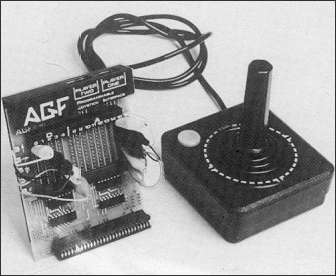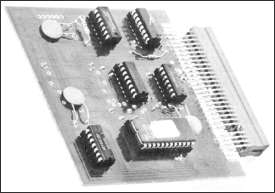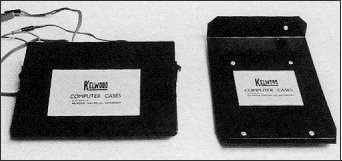| Hardware World |

AGF has produced a programmable version of its joystick board which works on either the ZX-81 or the Spectrum. There are two joystick sockets for standard Atari-type joysticks but they both operate the same keys. There is no longer a need for a specially modified joystick. The programming is done for each of the five positions of <, >, :, /, and FIRE button by two crocodile clips for each of the positions.
One clip selects one of five 'D' bars and the other one of the 'A' bars. Thus any of the keys on the 40-key keyboard can be simulated by various combinations of the two clips.
A chart is given on the back of the joystick giving the 'D' and 'A' numbers for the various keys.
It would have been far easier to use if it had been set out like the keyboard in a 10 by 4 line matrix instead of an 8 by 5 matrix. It would also have been useful to see that or a picture of the keyboard showing the relative 'A' and 'D' lines in the instructions.
Ten programming cards allow the user to mark the position of the clips for various games, so reference to the instructions is not required every time. Extra packs of 10 can be purchased for £1.
The board has an extension piece on the back for any other add-ons and is easy to use.
One difficulty might occur for people who have fitted a ZX-81 or Spectrum into a case; the crocodile clips may not fit between the case and the board which is tight against the back of the computer. The board should be very popular with games users as it means that any software can be converted to use joysticks without special tapes or joystick-adapted programs. It cannot be out-dated as all games have to be designed to use the keyboard.
The joystick board costs £33.95 and includes a demonstration tape. Joysticks cost £7.54 from AGF Hardware, West Sussex.
STEATITE Insulations has produced one of the most stylish keyboards yet for the ZX-81. It has a sloped front and 40 push-button keys. The keys are labelled just like the ZX-81 with keywords printed on the case. The ZX-81 will not at present fit inside the keyboard; its steel base provides no room to fit it but Steatite plans to change that. The ZX-81 connections are made by soldering two cable strips under the keyboard sockets after pushing them through the hole above the ZX-81 keyboard.
The instructions are clear and simple and the keys a pleasure to use. The only problem seems to be dished tops of the keys which are a little difficult to insert. Steatite says that it wants to improve the keyboard as much as possible.
Contact Steatite Insulations Ltd, Birmingham for the keyboard, which costs £30.95 inc. VAT and postage.
IN THE JULY issue a review of ZX-81 RAM packs omitted the name and address of Audio Computers. It has now sent a newer version of its RAM pack which it has been selling for the last three months. It is much better than the one tested previously as the edge connector is different - it is now black with a tinned spring instead of gold-plated - and has longer feet to take it up to the correct height. The RAM pack grips with a ridge of plastic on top of the ZX-81.
Audio Computers, Essex. The price of the 16K RAM pack is £19.95 plus £1 postage and packing.
COMPUTERLOCK produces a large black tray and stand for the ZX-81 or Spectrum which tidies all the wiring for a computer. You can stand a TV set on top of the stand, which is about 9in. high, to provide a better view. The tray is large - 25x17in. with a 1in. wide ridge all the way round. The TV stand should support the weight of most TVs and the model tested had the two extra mains switches fitted. They are optional extras at £3 each but you will have to wire them to the mains yourself. If you are unsure you can ask an electrician to wire it from the diagram provided.
A hole in the front of the stand permits access to the keyboard but the remainder of the wiring is hidden.
The cassette leads can be taken out of the side of the stand at the left but they will be near the mains leads, as that is the only exit. It will not be possible to use the Sinclair printer as it will be under the stand, as well as any Microdrives.
Altogether a sturdy package but it would be difficult to use if you intend to add anything on the back of the computer which requires access during programming. The Computerlock console costs £31.50 and is suitable for the ZX-81 or the Spectrum. Computerlock, West Sussex.

ORME ELECTRONICS Eprom Read card for the 16K and 48K Spectrum fits into the ROM space which is unused at present and can provide more facilities for Basic programs. With the EPROM I fitted, 10 extra routines are added for program editing, such as block delete of any section of program, re-numbering, variables dump. Commands which can be used in programs include left and right scrolls of the screen, TEXT justifier-to the printer only- and a very good sprite routine which will allow you to print various-sized characters at any location on the screen.
It will also allow you to turn round the characters by 90 degrees and print them in inverse and/or over other characters. There is also an extra graphics set which can be called-up from the ROM into the user-definable graphics area.
Each of the routines is used by giving a RANDOMISE USR-variable-command. An OUT command must also be used to change to a different section of routines as only 1K of the ROM is available at a time. The first routine is called by a number every time the program is RUN and that sets up the variable names to be used in the rest of the program. So, for instance, RANDOMISE USR REN would renumber all the lines in increments of 10 from 10.
The routines are easy to use if the examples are followed to the letter. VRD - variable dump - works only on variables created after the variable set-up routine and deletion of lines works only with lower-case REM del statements.
The EPROM board for use with motherboards costs £18.50 and the direct connecting type £21.25. Tape control costs £3.45 extra, as does EPROM I at £9.95. Postage and packing costs 75 pence for the U.K. and £1.75 overseas. Orme Electronics, Cornwall.
IN THE AUGUST issue in Hardware World, we gave the price of the Tactile keyboard as £99.95. It should have been £9.95, with the price of the demonstration tape as £5.95 and not £92.95.
We also said that the Jiles tape copier cost £99.95. It should be £9.95.
COBRA has been advertising its RS232 interface for the ZX-81 for some time. Its TMS terminal package consists of a tape and a black box which fits on to the rear of the ZX-81. Out of the black box emerges a single grey lead containing three wires, one 0V, one red output wire and one blue input wire. The wires need to be connected to a modem and a 300 baud acoustic modem was used to try the TMS pack with Telecom Gold.
Once the interface and a 16K or bigger RAM pack is plugged into the back of the ZX-81 the power can be turned on and the TMS tape LOADed. Telecom Gold service was dialled to gain access to a private database run by Cobra.
The TMS program must first be set up for the correct speed, number of bits sent by the use of a very good menu which allows you to select only one character option for each instruction. Cursor controls are provided to move from one instruction to the next.
If a selection is incorrect the program will not leave the menu when pressing NEWLINE and will place an asterisk over the mistake.
Among the options of the program are the ability to send control characters - for special options - upper- and lower-case, even though the ZX-81 will display only upper-case - and obtain a hard copy of the result on the Sinclair printer.
Once on the Cobra database you have a choice of playing games, sending messages to another user via the Mail Box facility or talking directly to another user as well as using Telecom Gold facilities. All the facilities and access have to be paid for. Cobra hopes to set up, with British Telecom, a network of home users to take advantage of the system.
Having an RS232 does not restrict you to using Telecom Gold; it can be used on most databases or bulletin boards like electronic newspapers run by user groups.
The system works well within the limits of the ZX-81 but a few limitations were noticed - not due to the interface. One was the ZX-81 keyboard which made reliable communication difficult and the other was the telephone line. The system used depends on the distant computer sending back your message for you to see - called full duplex - and the message can be garbled both ways, leaving you unsure whether it was due to your mistake or that of the system. That was due mainly to line noise.
The TMS package costs £71 from Cobra Technology Ltd, London.

KELWOOD COMPUTER cases has two computer stands - the Wobble Stopper for the ZX-81 and the Power Base which has versions for both the ZX-81 and Spectrum.
The Wobble Stopper is in three versions - small, tilted and large, for use with the Sinclair printers. Tilted versions are available in small and large sizes. All versions have a white nylon screw at the back which is tightened to prevent the wobble, clamping the RAM pack firmly to the ZX-81.
The Power Base is a sloping stand of about 15 degrees which has two rocker switches mounted on the sides. The right-hand side switch controls the power to the computer and can be used as a RESET switch. The power plug from the power pack is plugged into the back of the stand and the computer obtains its power from a lead which is terminated inside the stand. The other switch controls the two MIC and EAR leads.
The cassette leads are intercepted and plugged into the stand from the computer; two 12in. long cassette leads are then plugged into the tape recorder from the stand. The front of the Power Base has a turned-up edge to hold the computer firmly. The only screws are for getting into the base and to hold the rocker switches and power socket to the case. They are also supplied with rubber feet.
Power Base and Wobble Stopper are available from Kelwood Computer Cases, Rotherham. The cost of the ZX-81 stand is £5.25 for the small and £5.75 for the large; tilted types cost £1 extra. Power Bases cost £13.50 for the Spectrum and £13 for the ZX-81, inc. VAT and postage.
EPROM SERVICES has a range of EPROMs available for the ZX-81. EPROM I contains 10 small routines for program editing such as block line delete, delete up/down from line x, re-numbering - only the line number, no GO TOs or GO SUBs - and various checks on memory such as program length.
The next 12 routines are for entering machine code into REM statements, in HEX only, and extending and modifying both the machine code and the REM statement. There is also a very useful hex dump facility to view an area of memory which gives eight columns of hex addresses and the data in them on the screen.
Sixteen more routines contained in the EPROM I deal with the screen display and, together with a 6116-type 2K RAM chip at addresses 14K-16K on the same board, allow you to store machine code or TV screens in the RAM. That data is thus protected from a Basic program and can be recalled at any time. That makes a total of 38 routines in one ROM, a real achievement.
EPROM II concerns tape routines for a rapid SAVE and LOAD. EPROM IV contains a very good ZX-81 monitor program. It requires that the board be fitted with the same 2K RAM as with EPROM I to store the monitor screen and separate machine code stack. All the system variables are saved on entering the monitor and all the various Z-80A registers can be set before entering a machine code routine.
Two more useful instructions include ZX-81 versions of the IN and OUT instructions on the Spectrum for transferring data to I/O ports. Machine code can be SAVEd and LOADed from the monitor under the name 'M'. The monitor will work on the minimum 1K RAM ZX-81 and does not require a 16K RAM pack.
Breakpoints and the dumping of the Z-80A internal registers is done into the 2K RAM so that a system crash does not result in the loss of code; a re-set key must be used and the power plug left in.
The EPROM board plus EPROM I is sold for £20 including VAT and postage. Additional EPROMs II to IV cost £10 each and the 6116 RAM costs £6. Eprom Services is at Leeds. It also does development work and EPROM copying/programming.